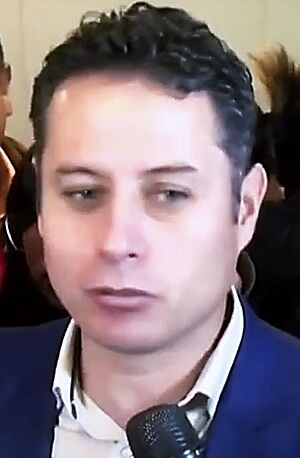Vice President of Bolivia facts for kids
Quick facts for kids Vice President of thePlurinational State of Bolivia |
|
|---|---|
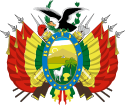
Coat of arms of Bolivia
|
|
| Residence | Vice Presidential Palace |
| Seat | La Paz |
| Nominator | Plurinational Electoral Organ |
| Appointer | Direct popular vote (two rounds if necessary) |
| Term length | Five years, renewable once consecutively |
| Inaugural holder | José Ramón de Loayza |
| Formation | 19 November 1826 |
| First holder | Álvaro García Linera |
| Salary | 22,904 bolivianos per month |
| Website | www.vicepresidencia.gob.bo |
The Vice President of Bolivia is a very important leader in Bolivia. This person holds the second-highest political position in the country. They help the President and can take over if the President cannot do their job. The Vice President also leads the country's main law-making group, called the Legislative Assembly.
The role of Vice President began on November 19, 1826. José Ramón de Loayza was the very first Vice President. Álvaro García Linera was a special Vice President. He was the last one for the old 'Republic of Bolivia' and the first for the new 'Plurinational State of Bolivia'.
Edmand Lara is the current Vice President of Bolivia. He took office on November 8, 2025.
If the President leaves office, the Vice President is next in line to become President. This has happened several times in Bolivia's history. For example, José Luis Tejada Sorzano and Carlos Mesa became President after their predecessors stepped down. Luis Adolfo Siles Salinas became President when the President before him passed away.
Some Vice Presidents were later elected President on their own, like Hernán Siles Zuazo and Jaime Paz Zamora. Others, such as José Miguel de Velasco, became President in different ways.
Contents
Understanding Bolivia's Vice Presidents
Early Days: The First Vice Presidents (1826-1836)
The role of Vice President was created on November 19, 1826. This happened during the time of President Antonio José de Sucre. It was part of Bolivia's first official rulebook, the Political Constitution of 1826. However, President Sucre did not choose anyone for the job during his term.
The first person elected as Vice President was José Miguel de Velasco in August 1828. But he ended up serving as acting President instead. Later, in December 1828, José Ramón de Loayza was chosen as Vice President. He served under President Pedro Blanco Soto.
| Vice Presidency | Vice President | Party | Designation | Government | President | |||
|---|---|---|---|---|---|---|---|---|
| 1 | 18 December 1828 – 1 January 1829 End of mandate |
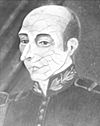 |
José Ramón de Loayza |
Independent | Elected by the Constituent Assembly | Provisional | Acting to 26 Dec. 1828 |
|
| Pedro Blanco Soto |
||||||||
| Office vacant 1 – 31 January 1829 | ||||||||
| 2 | 31 January 1829 – 23 July 1835 Dismissed |
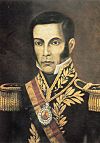 |
José Miguel de Velasco Franco |
Independent | Elected by the Constituent Assembly | Provisional (31 January 1829) |
Acting to 24 May 1829 |
|
| Reelected by the Constituent Congress | Constitutional
(14 August 1831) |
Andrés de Santa Cruz |
||||||
| 3 | 23 July 1835 – 28 October 1836 Legal change |
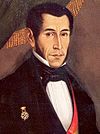 |
Mariano Enrique Calvo |
Independent | Appointed by Andrés de Santa Cruz | Constitutional | ||
A Time of Change: The Bolivian State (1836-1839)
The Bolivian State was one of three parts of the Peru-Bolivian Confederation. On October 28, 1836, Andrés de Santa Cruz became the main leader of this Confederation. He was also the president of the Bolivian State. Mariano Enrique Calvo served as Vice President during this time. He often acted as president when Santa Cruz was in Peru.
| Vice Presidency | Vice President | Party | Designation | Government | President | |||
|---|---|---|---|---|---|---|---|---|
| 3 | 28 October 1836 – 20 February 1839 Resigned from office |
 |
Mariano Enrique Calvo |
Independent | Elected by the Congress of Tapacarí | Constitutional | Andrés de Santa Cruz |
|
| Acting since 1836 |
||||||||
The Republic of Bolivia: A Long History (1880-2009)
After the Peru-Bolivian Confederation ended, Jose Miguel de Velasco became president. He brought back the Republic of Bolivia. In 1839, a new constitution removed the Vice President role. Instead, the leader of the Senate was next in line for the presidency. This changed in 1878 when the Vice President position was brought back.
A unique time came in 1880 when Bolivia had two Vice Presidents. Aniceto Arce and Belisario Salinas were chosen as the first and second Vice Presidents. The first Vice President led the Senate and could replace the President. The second Vice President would only step in if the first Vice President could not. This system of two Vice Presidents lasted until 1921.
The role of Vice President was removed again in 1939. But it was brought back in 1945 during President Gualberto Villarroel's time.
| Vice Presidency | Vice President | Party | Election | Government | President | |||
|---|---|---|---|---|---|---|---|---|
| 4 | 31 May 1880 – 11 March 1881 Dismissed |
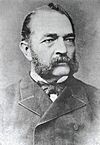 |
Aniceto Arce | Conservative | Elected by the National Convention |
Constitutional (1st) |
Narciso Campero | |
| 5 | 31 May 1880 – 4 September 1884 End of term |
 |
Belisario Salinas | Constitutional (2nd) |
||||
| 6 | 4 September 1884 – 15 August 1888 End of term |
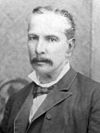 |
Mariano Baptista | Conservative | 1884 | Constitutional (1st) |
Gregorio Pacheco | |
| 7 |  |
Jorge Oblitas | Constitutional (2nd) |
|||||
| 8 | 15 August 1888 – 11 August 1892 End of term |
 |
José Manuel del Carpio |
Conservative | 1888 | Constitutional (1st) |
Aniceto Arce | |
| 9 | 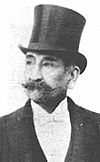 |
Serapio Reyes Ortiz |
Constitutional (2nd) |
|||||
| 10 | 11 August 1892 – 19 August 1896 End of term |
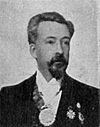 |
Severo Fernández | Conservative | 1892 | Constitutional (1st) |
Mariano Baptista | |
| 11 | 19 August 1896 – 12 April 1899 Removed from office unexpectedly |
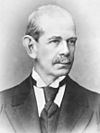 |
Rafael Peña de Flores |
Conservative | 1896 | Constitutional (1st) |
Severo Fernández | |
| 12 |  |
Jenaro Sanjinés | Constitutional (2nd) |
|||||
| Office vacant 12 April – 25 October 1899 | ||||||||
| 13 | 25 October 1899 – 23 January 1903 Dismissed |
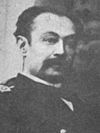 |
Lucio Pérez Velasco |
Liberal | Elected by the National Convention |
Constitutional (1st) |
José Manuel Pando |
|
| 14 | 25 October 1899 – 14 August 1904 End of term |
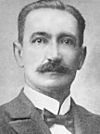 |
Aníbal Capriles Cabrera |
Constitutional (2nd) |
||||
| 15 | 14 August 1904 – 12 August 1909 End of term |
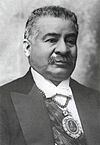 |
Eliodoro Villazón | Liberal | 1904 | Constitutional (1st) |
Ismael Montes | |
| 16 | 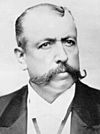 |
Valentín Abecia Ayllón |
Constitutional (2nd) |
|||||
| 17 | 12 August 1909 – 14 August 1913 End of term |
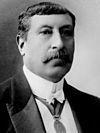 |
Macario Pinilla Vargas |
Liberal | 1909 | Constitutional (1st) |
Eliodoro Villazón | |
| 18 | 12 August 1909 – 1 October 1915 Died in office |
 |
Juan Misael Saracho |
Constitutional (2nd) |
||||
| Liberal | 1913 | Constitutional (1st) |
Ismael Montes | |||||
| 19 | 14 August 1913 – 15 August 1917 End of term |
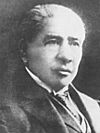 |
José Carrasco Torrico |
Constitutional (2nd) |
||||
| 20 | 15 August 1917 – 12 July 1920 Removed from office unexpectedly |
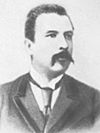 |
Ismael Vázquez Virreira |
Liberal | 1917 | Constitutional (1st) |
José Gutiérrez Guerra |
|
| 21 | 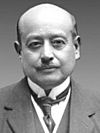 |
José Santos Quinteros |
Constitutional (2nd) |
|||||
| Office vacant 13 July 1920 – 10 January 1926 | ||||||||
| 22 | 10 January 1926 – 28 May 1930 De facto exiled |
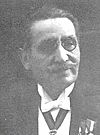 |
Abdón Saavedra | PRS | Dec 1925 | Constitutional | Hernando Siles Reyes |
|
| Office vacant 28 May 1930 – 5 March 1931 | ||||||||
| 23 | 5 March 1931 – 1 December 1934 Assumed presidency |
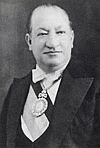 |
José Luis Tejada Sorzano |
Liberal | 1931 | Constitutional | Daniel Salamanca Urey |
|
| Office vacant 1 December 1934 – 28 May 1938 | ||||||||
| 24 | 28 May 1938 – 24 April 1939 Dismissed |
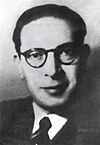 |
Enrique Baldivieso | PSU | Elected by the National Convention | Constitutional | Germán Busch | |
| Office vacant 24 April – 24 November 1945 | ||||||||
| 25 | 6 November 1945 – 21 July 1946 Removed from office unexpectedly |
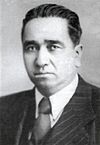 |
Julián Montellano | MNR | Elected by the National Convention | Constitutional | Gualberto Villarroel | |
| Office vacant 21 July 1946 – 10 March 1947 | ||||||||
| 26 | 10 March 1947 – 24 October 1949 Assumed presidency |
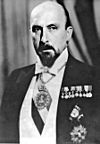 |
Mamerto Urriolagoitía | PURS | 1947 | Constitutional | Enrique Hertzog | |
| Office vacant 22 October 1949 – 11 April 1952 | ||||||||
| 27 | 11 April 1952 – 6 August 1956 End of term |
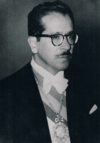 |
Hernán Siles Zuazo |
MNR | Installed by a sudden change in leadership | De facto | Acting to 15 Apr. 1952 |
|
| Víctor Paz Estenssoro |
||||||||
| 28 | 6 August 1956 – 24 June 1957 Resigned from office |
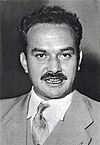 |
Ñuflo Chávez Ortiz |
MNR | 1956 | Constitutional | Hernán Siles Zuazo |
|
| Office vacant 24 June 1957 – 6 August 1960 | ||||||||
| 29 | 6 August 1960 – 6 August 1964 End of term |
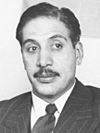 |
Juan Lechín Oquendo |
MNR | 1960 | Constitutional | rowspan="2" Víctor Paz Estenssoro |
|
| 30 | 6 August 1964 – 4 November 1964 Assumed presidency |
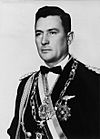 |
René Barrientos | MNR | 1964 | Constitutional | ||
| Office vacant 5 November 1964 – 6 August 1966 | ||||||||
| 31 | 6 August 1966 – 27 April 1969 Assumed presidency |
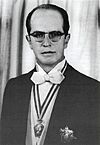 |
Luis Adolfo Siles Salinas |
PSD | 1966 | Constitutional | René Barrientos | |
| Office vacant 27 April 1969 – 10 October 1982 | ||||||||
| 32 | 10 October 1982 – 14 December 1984 Resigned from office |
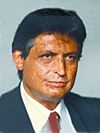 |
Jaime Paz Zamora |
MIR | 1980 | Constitutional | Hernán Siles Zuazo |
|
| Office vacant 14 December 1984 – 6 August 1985 | ||||||||
| 33 | 6 August 1985 – 6 August 1989 End of term |
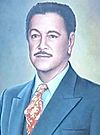 |
Julio Garrett Ayllón |
MNR | 1985 | Constitutional | Víctor Paz Estenssoro |
|
| 34 | 6 August 1989 – 6 August 1993 End of term |
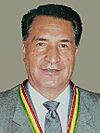 |
Luis Ossio | PDC | 1989 | Constitutional | Jaime Paz Zamora |
|
| 35 | 6 August 1993 – 6 August 1997 End of term |
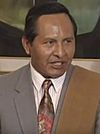 |
Víctor Hugo Cárdenas |
MRTKL | 1993 | Constitutional | Gonzalo Sánchez de Lozada |
|
| 36 | 6 August 1997 – 7 August 2001 Assumed presidency |
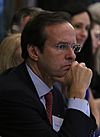 |
Jorge Quiroga | ADN | 1997 | Constitutional | Hugo Banzer | |
| Office vacant 7 August 2001 – 6 August 2002 | ||||||||
| 37 | 6 August 2002 – 17 October 2003 Assumed presidency |
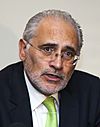 |
Carlos Mesa | Independent | 2002 | Constitutional | Gonzalo Sánchez de Lozada |
|
| Office vacant 17 October 2003 – 22 January 2006 | ||||||||
| 38 | 22 January 2006 – 22 January 2010 Legal change |
 |
Álvaro García Linera |
MAS | 2005 | Constitutional | Evo Morales | |
Modern Bolivia: The Plurinational State (2009-Present)
The 'Plurinational State of Bolivia' began with a new constitution in 2009. This new rulebook was approved by the people on January 25, 2009. It changed the country's official name from 'Republic of Bolivia'. To follow the new constitution, elections were held in December 2009. President Evo Morales and Vice President Álvaro García Linera won again. This made Álvaro García Linera the last Vice President of the Republic and the first of the Plurinational State.
| Vice Presidency | Vice President | Party | Election | Government | President | |||
|---|---|---|---|---|---|---|---|---|
| 38 | 22 January 2010 – 10 November 2019 Resigned from office |
 |
Álvaro García Linera |
MAS | 2009 | Constitutional | Evo Morales | |
| 2014 | ||||||||
| Office vacant 10 November 2019 – 8 November 2020 | ||||||||
| 39 | 8 November 2020 – 8 November 2025 |
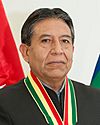 |
David Choquehuanca | MAS | 2020 | Constitutional | Luis Arce | |
| 40 | 8 November 2025 - Incumbent |
 |
Edmand Lara | PDC | 2025 | Constitutional | Rodrigo Paz Pereira | |
Timeline of Vice Presidents
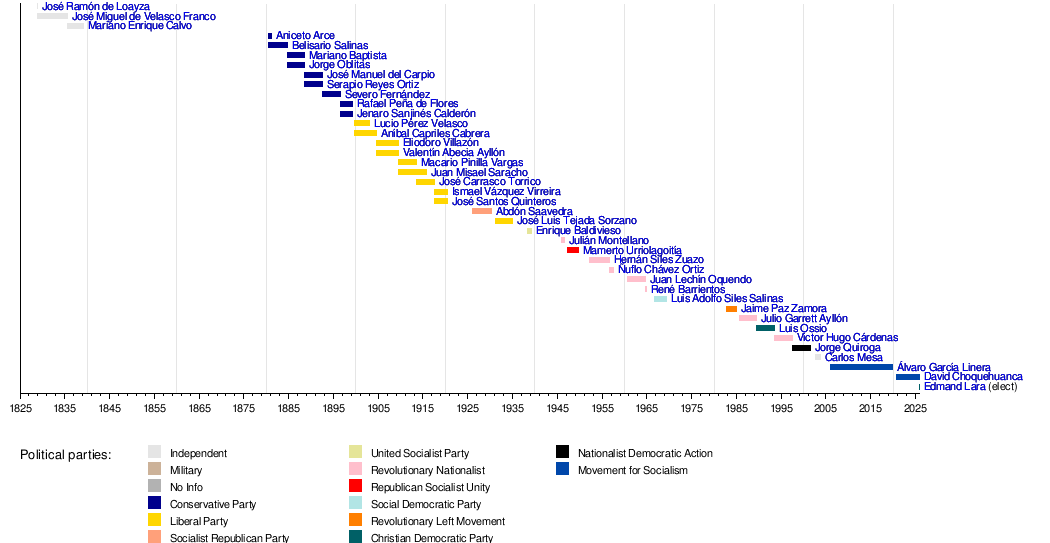
See also
 In Spanish: Vicepresidente de Bolivia para niños
In Spanish: Vicepresidente de Bolivia para niños


